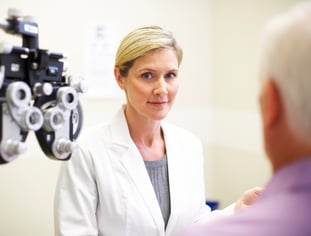Top Factors to Check Out an Optometrist Chino for Your Eye Health
Top Factors to Check Out an Optometrist Chino for Your Eye Health
Blog Article
Exploring the current Technical Advancements in Optometry and What They Mean for Optometrists
From the accuracy of Optical Coherence Tomography to the nuanced understandings offered by AI-driven diagnostic devices, these innovations are setting new standards in patient analysis and treatment. As these developments permeate the method, eye doctors are encountered with the challenge of accepting these devices to boost client results.
Developments in Diagnostic Tools
Advancing the area of optometry, innovations in analysis tools have reinvented the way eye care specialists examine and diagnose visual impairments and eye problems. The previous years has observed substantial technical developments, allowing more exact and extensive analyses.
An additional key technology is the intro of sophisticated corneal topography systems, which map the surface curvature of the cornea with precision. These devices are particularly advantageous for suitable call lenses and diagnosing corneal disorders. Electronic retinal imaging has actually changed traditional ophthalmoscopy, offering in-depth, breathtaking sights of the retina that facilitate extensive visual assessments.
The growth of wavefront aberrometry has additionally been essential, allowing the evaluation of refractive errors with unequaled precision (Eye Doctor). This innovation assists in personalizing restorative lenses and improving surgical outcomes for refractive surgical treatments. Collectively, these diagnostic improvements encourage eye doctors to supply superior client care, guaranteeing early treatment and customized therapy methods, eventually improving visual health outcomes
AI in Person Administration
Building on the foundation of cutting-edge analysis devices, the unification of expert system (AI) in patient administration represents a transformative jump for optometry. AI systems are significantly used to boost effectiveness, accuracy, and customization in person treatment. By evaluating vast amounts of data, AI can recognize patterns and predict potential ocular problems, allowing optometrists to tailor interventions extra efficiently. This capacity is critical in handling persistent eye conditions such as glaucoma and diabetic person retinopathy, where early discovery and continuous monitoring are vital.
Furthermore, AI-driven platforms promote streamlined individual communications and administrative procedures. Automated scheduling, online consultations, and individualized follow-up plans not just boost individual fulfillment but likewise maximize time management for experts. These systems can triage clients based upon the necessity of their conditions, making certain that those in vital demand receive timely attention.
In addition, AI enhances decision-making by giving optometrists with evidence-based recommendations and treatment pathways. By integrating information from digital health records, AI devices offer insights that notify scientific decisions, decreasing the danger of errors and improving person outcomes. As AI remains to evolve, its role in individual monitoring will likely increase, improving the landscape of optometric treatment.
Advances in Retinal Imaging
In the realm of optometry, retinal imaging has seen amazing technological advancements that are enhancing diagnostic capabilities and client treatment. Advancements such as Optical Coherence Tomography (OCT) and fundus digital photography have transformed just how eye doctors imagine and assess the retina.
Improved imaging modalities like OCT angiography are more refining analysis accuracy. This non-invasive method maps blood flow in the retina, supplying essential insights into vascular health and wellness without the requirement for color injections. Furthermore, adaptive optics technology is being incorporated into retinal imaging systems to fix ocular aberrations, delivering unmatched photo clarity. Such developments facilitate the recognition of minute retinal adjustments that might signify disease development.
In addition, developments in expert system are augmenting retinal imaging by making it possible for computerized analysis of pop over here huge datasets. These systems help eye doctors in identifying patterns a sign of pathology, consequently enhancing diagnostic precision and performance. Collectively, these innovations are changing retinal imaging right into a cornerstone of modern eye treatment, boosting outcomes and increasing healing possibilities.
Teleoptometry's Expanding Role
Teleoptometry is increasingly coming to be a crucial part of eye care, driven by advancements in digital interaction and analysis devices. This is especially helpful in underserved and rural areas where access to specialized eye treatment view website is often restricted.
The integration of expert system (AI) additional improves teleoptometry, allowing the analysis of aesthetic data and helping in the discovery of ocular problems such as glaucoma and diabetic retinopathy. AI-powered formulas can quickly interpret complicated imaging information, providing optometrists with important understandings that reinforce professional decision-making.
Furthermore, teleoptometry supports continuity of care via smooth assimilation with electronic health records (EHRs), permitting optometrists to maintain detailed client backgrounds. This makes sure that individuals obtain individualized and consistent care also when consulting with various practitioners.
Despite these advantages, difficulties continue to be, consisting of making certain information protection and taking care of person expectations. Teleoptometry represents a significant stride towards more accessible, reliable, and patient-centered eye treatment. As innovation evolves, its function is poised to broaden further.

Future Fads in Eye Care
A myriad of ingenious patterns is established to reshape the future of eye treatment, driven by technological advancements and the developing needs of individuals. One considerable fad is the combination of artificial intelligence (AI) in diagnostics, which assures to improve the accuracy and efficiency of eye exams. AI algorithms can evaluate substantial quantities of information from retinal pictures, possibly finding problems like diabetic retinopathy and glaucoma earlier than conventional techniques.
Additionally, individualized medicine is getting traction in optometry, with hereditary testing educating personalized treatment strategies. This method intends to enhance person outcomes by tailoring treatments to individual hereditary accounts. Wearable modern technology, such as smart get in touch with lenses, is also on the horizon, providing real-time surveillance of intraocular pressure or glucose levels, thus supplying constant insights into systemic and eye health.
The adoption of enhanced fact (AR) and online reality (VIRTUAL REALITY) in training and client education is another arising pattern. These modern technologies supply immersive experiences that can improve understanding and abilities both for optometrists and people. As these patterns progress, eye doctors must remain abreast of technical advancements to supply innovative care, here are the findings making certain enhanced client results and complete satisfaction in the vibrant landscape of eye care.
Final Thought

Jointly, these diagnostic advancements empower optometrists to deliver premium patient care, making sure very early treatment and tailored therapy methods, inevitably improving aesthetic wellness outcomes.

As these modern technologies proceed to evolve, eye doctors must adapt and include them into practice, inevitably enhancing process effectiveness and elevating the requirement of eye care provided to clients.
Report this page